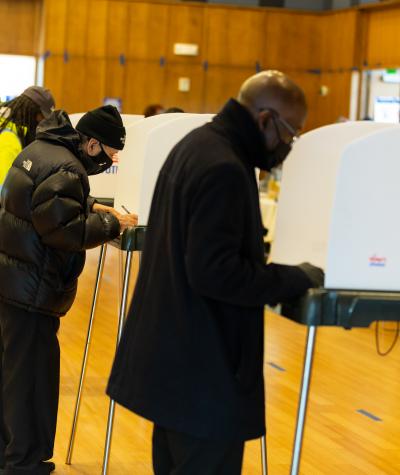Our democracy works best when every voter can participate, but the way elections are run in each state can have a huge impact on whether voters are able to participate.
After each federal general election, the U.S. Election Assistance Commission (EAC) conducts the Election Administration and Voting Survey, which asks state election officials to report data related to voter registrations, voter lists, mail ballots, and provisional ballots.
Campaign Legal Center published a report outlining several insights from the 2020 EAC survey data into how elections were administered at the height of the COVID-19 pandemic, and what that can teach us about how elections should be administered in the future to better serve voters—and steps that can be taken right now to ensure that every eligible vote is counted in the midterms.
MAIL BALLOTS
The survey data emphasizes the tremendous benefits of vote-by-mail, which has improved voter participation while also ensuring elections are safe and secure. Despite the pandemic, turnout for the 2020 general election reached the highest levels ever documented, in large part due to voters taking advantage of more access to vote-by-mail options.
Slightly more than 43% of voters participated in the election with a mailed ballot and 98.8% of all returned mail ballots were counted. Some states that introduced no-excuse vote-by-mail during the pandemic have passed laws to make this a permanent feature of their elections; other states would do well to follow suit.
The most common reason for rejecting mail ballots was non-matching signatures, accounting for about a third of all rejections. This data point is troubling given that signature verification is notoriously unreliable and error-prone. To address this, states should implement robust programs to notify voters of any signature problems—ideally by phone, text, or email— so voters can verify their identity and ensure their votes are counted.
VOTER PURGES
Voter registration lists need to be updated, but when list maintenance is performed overzealously or with inaccurate data it can disenfranchise voters by removing them from the rolls with little notice.
Most states removed less than 10% of their voters between the November 2018 and 2020 general elections, but some states had higher than average purge rates, namely Indiana (18%), North Carolina (15%), Massachusetts (14%), Wyoming (13%), Virginia (13%), Maine (12%), New Hampshire (12%), and Ohio (11%).
While there are legitimate reasons to remove a voter from the rolls, for example if they died or moved to a different state, it’s important for states to be transparent about their list maintenance practices and for organizations to monitor voter purge activity ahead of the midterms so voters are not being removed based on error-prone data, racial discrimination or politically-motivated criteria.
VOTER REGISTRATION
In the run-up to the 2020 general election, there was a huge spike in voter registration—election officials reported a 33.8% increase in the number of registration applications received. Most of these new registration applications were accepted and processed. In fact, the national average for rejected applications was only 7.8%.
In every state, the vast majority of new voter registrations were completed through Department of Motor Vehicles (DMV) offices, which the National Voting Rights Act (NVRA) designates as a mandatory voter registration agency.
Public assistances offices—like Medicaid and Supplemental Nutrition Assistance Program (SNAP) offices—are also mandatory voter registration agencies, but very few registration forms were submitted through those offices in 2020 compared to previous years.
While these low numbers could be attributed to the COVID-19 pandemic, since voters had fewer in-person interactions at public assistance offices, it’s important to make sure clients are provided with sufficient information and assistance with registering to vote for future elections.
One way to modernize voter registration is automatic voter registration (AVR). In states with AVR, citizens are automatically registered to vote when they interact with a government agency, like the DMV, unless the voter explicitly declines. When the voter interacts with another agency, their information is automatically updated, ensuring voter records are always up to date.
PROVISIONAL BALLOTS
Provisional ballots are a fail-safe to ensure that voters whose eligibility is uncertain at the polls are not unfairly excluded from the voting process. Provisional ballots are generally kept separate from other ballots until after the election, when election workers can verify the voter’s identity and registration status to determine whether the ballot should be counted or rejected.
Nationwide, 78.3% of the provisional ballots cast were counted, either in part or in full, amounting to a little more than 1.3 million votes counted. The most common reason provisional ballots were rejected was that the voter was not registered.
In addition to AVR, states can address this issue by implementing same-day voter registration. Same day registration allows people to register to vote the same day they cast their ballot and is proven to increase voter turnout by an average of 5%.
CONCLUSION
Today, there are more voters participating in our democracy than ever before. Data from the 2020 election has revealed that greater access to vote by mail during the pandemic improved voter participation, as did registering voters through public agencies like the DMV.
2020 election data also reveals where gaps in voter access still exist. Voter purges and error-prone signature matching policies can disenfranchise voters, sometimes without the voter’s knowledge. Measures like AVR, same day registration and robust notice procedures for problems with mail ballots would help close those gaps for future elections, so our democracy is truly accessible to every voter.

